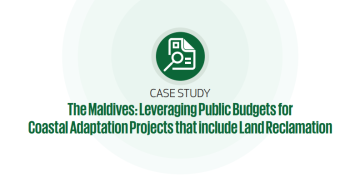
The Maldives consists of 1,192 islands in the middle of the Indian Ocean and is at high risk from rising sea-levels. More than 44 percent of settlements and 70 percent of all critical infrastructure are located within 100 meters of shoreline, which makes them highly vulnerable to flooding and coastal erosion increased by climate change induced sea-level rise.
In addition to general population growth, high rates of urbanization and migration cause the capital, Malé, one of the most densely populated cities in the world to face challenges with housing one-third of the national population.To overcome these challenges, coastal adaptation in the Maldives is key. Land reclamation presents a great potential for revenue generation that can be used for coastal adaptation.
Indeed, while coastal adaptation is economically beneficial particularly in densely populated urban areas, these opportunities are often not realized due to the high upfront costs and scarce public resources for adaptation. Public financing constraints can be overcome by investing in projects integrating coastal adaptation and land reclamation or urban land redevelopment because the public actor can generate revenues through selling or leasing the newly available land. In urban settings, such as Malé in the Maldives, land values are sufficiently high for generating either market or tax revenues to fund coastal adaptation measures.




